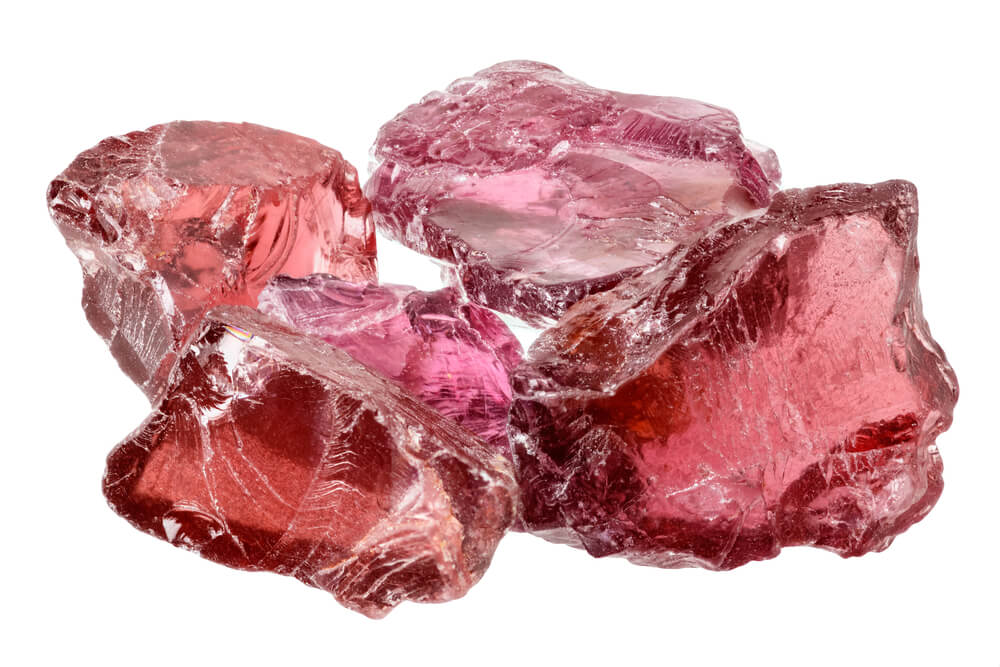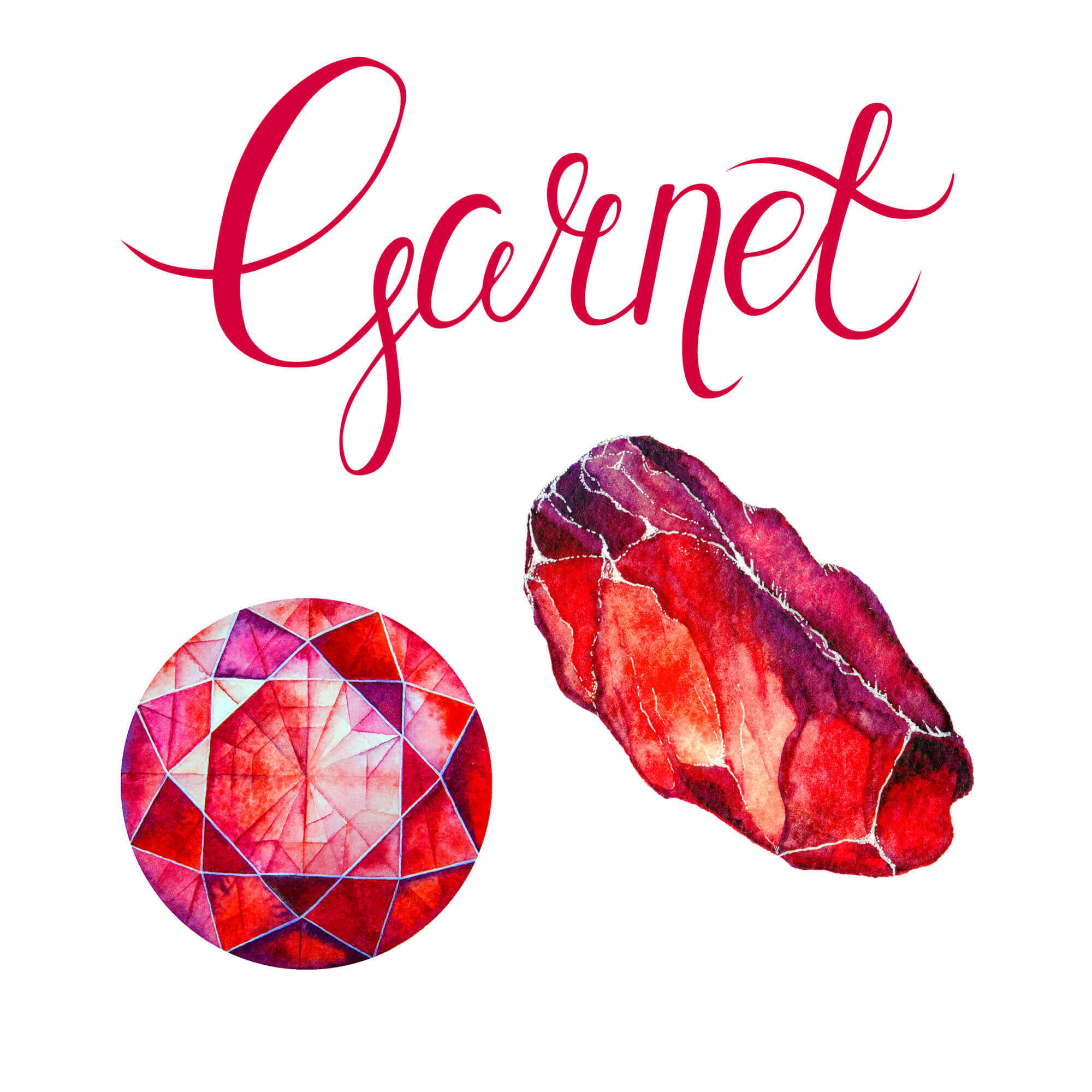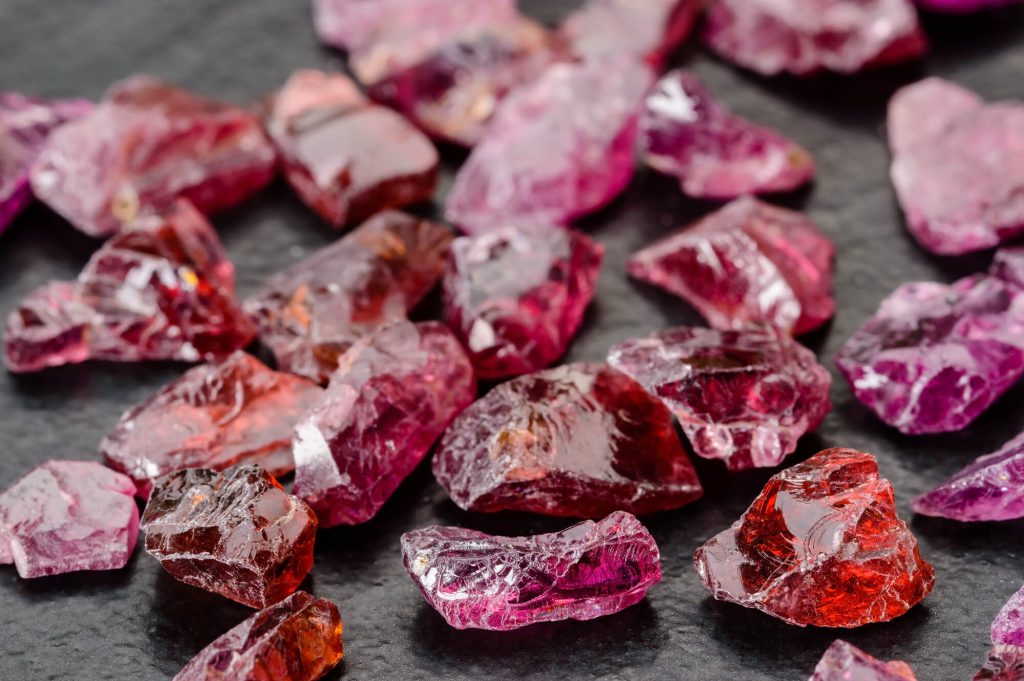Introduction to Garnet
Garnet is a birthstone for January, and it has been loved and treasured for centuries for its stunning beauty and brilliance. It is most frequently recognized in red, like seeds of a pomegranate. However, garnets come in oranges, greens, purples and even blues. The garnet is a versatilely esteemed stone that it is a preference of collectors as well as gemstone enthusiasts from which nice pieces of jewelry can sprout out.
Garnet comes from a Latin word ‘granatum’ which means ‘pomegranate seed’. The history of garnet goes back to the Bronze Age when it was used in making jewellery. Since then, its timeless beauty, along with comparatively high level of hardness and therefore durability, has always been a most sought after choice for every type of jewellery.
| Aspect | Description |
|---|---|
| Birthstone Month | January |
| Colors | It has traditionally been red but is also orange, green, purple; and blue |
| Notable Varieties | Almandine, Pyrope, Spessartine, Demantoid, Tsavorite, Andradite, Uvarovite |
| Hardness | Lies between 6.5 and 7.5 on the Mohs scale |
| Formation | Symbolism |
| Forms under high pressure and temperature, usually forming metamorphic and igneous rocks | |
| Mythology | Friendship, trust, protection, love, commitment |
| Historical Uses | Used in jewelry and decorative crafts across cultures, from Ancient Egyptians to Victorians |
| Usage | Used for all kind of jewelery – rings, earrings, necklaces, bracelets |
| Caring & Cleaning | Clean using some mild soap and warm water; avoid harsh chemicals, extreme heat and ultrasonic cleaners |
| Mental & Emotional Significance | Relevance with health being strong, relationships being sturdy and boosting of self-esteem
Origin and History of Garnet
Garnet has a long history that spans many cultures and thousands of years. The ancient Egyptians valued garnets enough to include them as inlays within their jewelry and decorative crafts, while others were placed within Greek and Roman jewelry. By the Middle Ages, garnets were used for jewelry and considered highly valuable.
Among the notable historical uses of garnet is its peculiar use by the Czechs in the middle ages. In this year, Bohemia, soon to be a part of the Czech Republic, flourished due to an abundance of garnets making the gemstone a substantial holder of the local economy. The Bohemian garnets of that era are well-known for their small size and intense fiery red color.
Garnets also feature in the Native American jewelry and ceremonial objects, where they came to be used for the garnet Victorian jewelry. Today, garnet still holds as an adored gemstone because of its numerous colors, high refractive index, and symbolic associations with friends’ trust, friendship, and safe travel.
From an ancient time to now garnet has been a treasured gem for its deep color that is irresistible for its beauty all across the world. From its mythology, symbolism, and distinctive properties understanding quite a picture of why garnet is really the perfect choice as January birthstone.
Mythology and Symbolism of Garnet
The garnet has always enjoyed a place of statures in the pages of mythology, religion, and culture. In most traditional Roman beliefs in ancient Rome, garnets were strongly believed to have the right of light powers and soldiers wore talismanic garnet embedded items during war to protect themselves from getting wounded. Also, through some tradition historical beliefs, they thought of these stones as potential elements of winning battles due to the possibility of resisting wounds and other injuries.
In Greek mythology, for example, the Goddess of harvest – Persephone, gives a garnet to Hades as an assurance token that she will safely return from the underworld. Making it a symbol of love, commitment and insurance against parting.
When considering the Christian faith, it is said that garnet symbolizes the blood of Christ as well as being the life-giving element. It has been used with a lot of flexibilities in the Christian religious items and also appeared in the Bible as ‘carbuncle’ referring to ‘little spark’.
In addition to interesting mythological meanings, garnet stands for deep friendship and trust, being ideal for pieces of friends’ jewelry. Named a birthstone of January, it is known to guard the wearer during travel and bring this person wealth and prosperity.

Types and Colors of Garnet
Though garnet is most commonly thought of as a deep, classic red gem, this stone group is actually a set of minerals in any color. There are many different types of garnet, each with its special range of colors and qualities.
The best known type is the Almandine, its crystal drawings range from a deep red to reddish-brown. Pyrope garnets are frequently bright, cherry red and Spessartine garnets exist in shades of orange and yellow. The garnets are bright green, bright to dark green, yellow-green to black in color respectively – Demantoid, Tsavorite garnet, as well as the Andradite garnets. Uvarovite garnet is the utmost rarity amid the garnet variety, with its dainty yet emblematically little crystals in an intense shade of emerald green.
Some garnet colors are so rare that they have made them out to be even more alluring. For example, the blue garnets capable of changing color under differing lighting conditions and are considered to be within the world’s rarest gemstone category. Similarly, as and when viewed either under natural or artificial light, the color-changing garnets will shift their hue.
From vibrant oranges to deep greens, truly garnets offer a spectacular palette making it THE birthstone to offer versatility and personalization in gem selection.
Physical Properties and Formation of Garnet
Garnet is the name of a group of silicate minerals that have been used since the Bronze Age as gemstones and abrasives. The same physical properties and crystal forms found in all species of garnets, with differences occurring in chemical composition.
These occur under high temperature and pressure conditions, and they are found in metamorphic rocks such as gneiss and schist. The other types of garnet are located in igneous rocks.
Garnets prove to be excellent materials for use in jewelry due to their being hard as well as durable. Garnets have hardness in the range of 6.5 to 7.5 on the Mohs scale of hardness, depending upon the variety.
This can range anywhere from vitreous (glasslike) to resinous (like hardened resin). Once again, depending on type of garnet, transparency of garnets can also present major differences where garnets can be transparent or opaque.
Jewel Design and Garnet
The versatility of colors of garnet along with the relative hardness and durability makes it a well like option for the designers of jewelry. Their brilliance and depth of color make garnets suitable for varied types of jewelry including rings and earrings as well as necklaces and bracelets.
Garnets are frequently cut in all standard shapes and contemporary cutting styles. However, the garnet is especially spectacular when faceted because this style enhances its color and brilliance. The solitaire displays a single well-cut garnet of deep red color or may be combined with other stones for more elaborate settings.
How to Take Care and Clean Garnet Jewelry
Being a gemstone jewelry, the garnet one needs particular care to look at its best. One is supposed to protect the glass from sharp blows which could take place in the event of damage of the stone. You can start cleaning your garnet jewelry with warm water and mild soap. By doing this, you can gently scrub your gemstone and your jewelry setting as you use a soft brush. After the cleaning step, you need to ensure that your garnet jewelry is dry before keeping them.
Never expose your garnet jewelry to harsh chemicals, extreme heat and ultrasonic cleaners. Handled well, the life of garnet jewelry can last a lifetime for ages.

Garnet: The January Birthstone
January’s birthstone, garnet, is a wonderful friend and trust symbol when choosing gifts. Associating garnet with the dawn of a new year makes it symbolic of new beginnings, revival, rejuvenation, and growth.
On the other hand, for those who were born on January, garnet ensures health, wealth, and happiness. Some believe that garnet can provide eternal happiness, health, and wealth too. Furthermore, the second and sixth wedding anniversary is symbolized by garnet which is a symbol of love and faithfulness amongst both partners.
Psychological and Emotional Meaning of Garnet
Garnet is connected to the heart and blood, symbolizing strong loving relationships and robust health. It’s thought to boost the self-esteem, combating feelings of inadequacy from giving in to self-criticism and clarify perception by amplifying one’s inner light of insight and realization. Furthermore, from a standpoint of psychology and emotions it’s said to inspire love, devotion, balance the sex drive while eliminating emotional disharmony.
Garnets have reportedly been used by many cultures as meditative stones. Some also believe that garnets help the body in healing because of higher regeneration of cells that in return heal the body. Others use garnet as a talisman for enhancing their creative thinking and gouging spiritual forces in the bodies.
Choose Garnet Birthstone Jewelry Piece
The choice of the garnet piece is, first of all, the matter of personal style and fashion preference. Since one can get garnets in several colors, first consideration could be that which is best suited for the person wearing it. The deep red garnets are classic and timeless, while orange or green garnets offer a unique and distinctive choice.
Consider also the style of jewelry, along with the setting. After all, garnets are highly versatile and combine well with every type of setting – be it vintage-look rings, modern-look minimalist earrings, or attention-garnering statement necklaces.
Lastly, it needs to be well-crafted, especially if the jewel will be worn regularly. Granted garnet is relatively hard and durable, it is still between set-up in a manner that protects it from potential damage.
Conclusion: The Lasting Appeal of Garnet
The garnet, with a myriad of colors and a long rich history, truly has an appeal that transcends all boundaries. From being ancient talismans to modern jewelry pieces, the garnet has proved timeless and continues to be regarded for its beauty as well as the symbolic meanings it possesses. Garnet, the birthstone of January, is a gift of love and friendship that will be cherished for many years. Whether you’re looking for a garnet jewelry piece for yourself or one that makes the perfect gift, you’re choosing a gemstone with a legacy every bit as vibrant as its colors.

